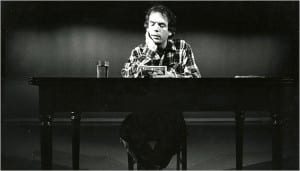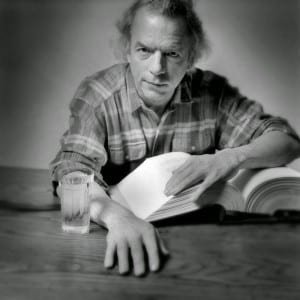SPALDING GRAY
(1941-2004).

Full name: Splading Rockwell Gray.
Born June 1941-January 11th 2004.
An American actor and writer known for his autobiographical monologues which were written and performed in both the theater and his own solo films, among others. Sadly Gray passed away in New York City after an apparent or supposed suicide in 2004 after reportedly jumping off a ferry, leaving behind two sons and a wife. For the purpose of this I will talk about a small collection of his works.
Filmed monologues.
Swimming In Cambodia.
Monster in a Box.
Terrors Of Pleasure.
Has been remembered and described as:
“The lone star of such peerless exercises in public introspection as “Swimming to Cambodia” and “Monster in a Box,” Mr. Gray was the ultimate stand-up soloist. He made it clear that his work was less about using his personality as a prism to refract the world than using the world to refract his personality.” Ben Brantley: The New York Times.
“During the 1980’s and 1990’s, a number of critics claimed that Gray actually created the genre of autobiographical performance. If that is an overstatement—and it is—Gray’s work still had an undeniable influence on a generation of writers (and performers) of autobiography, creative nonfiction and postmodern storytelling, as well as those who have followed.”
“While his performances resembled — and influenced — the confessional style of contemporaries like Eric Bogosian and John Leguizamo, Mr. Gray’s work had a search for larger meaning — a quest, as he put it, for ”the perfect moment.”
A film dedicated to his memory:
And Everything Is Going Fine. A Stephen Seidenberg Tribute.
On the subject of suicide in Gray Spalding’s work.
“What’s so bizarre in all this,” Mr. Soderbergh said, “was the central role suicide played in his life.” Gray’s mother committed suicide when she was 52, and his work is haunted by his memory of that act and his fear that he would be compelled to repeat it. “It’s right at the core of the work, and it’s discussed in such a wide-ranging way,” Mr. Soderbergh said. “And maybe that’s what frightened me when I heard about his accident.”
(IFCFilmsVOD, 2012).
The joy and ecstasy of Gray’s performances can be seen through his vast energy and simplicity when tackling diverse and complex subject matters, ones that are often unspoken or to taboo for conventional performances to tackle. Of choosing a taboo subject matter can always help highlight a performance into one that stands above the rest, outside of traditional theater. This performance style allows him a very exclusive relationship with the viewer as you are slowly brought into his world, nurtured before being thrown in at the deep end. His very pace and energy keep you engaged until you realize the topic his is covering I.e. Swimming to Cambodia that tackles countless killings and mass-genocide, however through Gray’s performance you are invested in his very character from start to finish.
Looking into my own style I believe I will borrow heavily from Gray’s technique of sitting and talking as myself to an intimate audience, I also believe that within my own performance they will carry strong connections, all be it a more more simpler version. I am lending my story’s and ideas within his style with my own simplistic take, outside of his unconventional sit-down theater.
His Methodology.
Always performs seated behind a desk with nothing but a microphone and single glass of water and his monologue manuscript. Using visual aids to help tell his stories. He once commented that:
“Looking back on it, telling stories to Liz, her sister Ellen, and their roommate every night when I’d get back, about my encounters on the streets. We all lived in this one house on Sixth Street and Avenue D. No television, and no radio really. That was really kind of the beginning of my storytelling”
“I go through three stages. The first is trying to figure out what I’m thinking about and talking about by actually doing it. I have never prewritten a monologue; I depend on working off the audience, making it like a dialogue.”
“Mr. Gray had decided to pursue the monologue as a type of performance art, and soon hit on his basic set (desk, water, notes) and approach (simple, measured, candid).”
“This is how I start. I sit down with a pencilled outline and tape record it as I perform it with an audience. What I start with is memory. All memory is a creative act. If you have a memory, you’re re-creating the original event. That’s why the O.J. Simpson trial went on for as long as it did. It’s based on recollection, and that’s a very loose and open thing, a creative thing. So my memory is my first structure. Then I listen to a tape of what I said and wonder how I can make it a little more dramatic and funny by juxtaposing a little hyperbole here and play with it a little bit there.”
Swimming to Cambodia
Swimming to Cambodia was originally a theater piece on which Gray spent two years working. The original running time of the performance was four hours long and took place over two nights. The condensed film version is eighty-four minuets. Gray first achieved prominence in the United States with his monologue Swimming to Cambodia, which he wrote in 1985 and was adapted into a film in 1987. This work was based particularly on his experience in a small role in the 1984 film The Killing Fields, which was filmed principally in Thailand. This film experience made Spalding question the senseless killings that occurred in such a tranquil setting.
(Readers Digest UK, 2015).
(ThoughtCoffee, 2009).
https://youtu.be/dJpl1TgwTDA?t=8
The main character, who is diagnosed with a rare ocular condition called Macular pucker. After hearing all of his options, such as Christian Science, Native American sweat lodges, and the “Elvis Presley of psychic surgeons”, and the dangers of what surgery could bring, he decides to go through the other forms of medicine provided. This in turn takes him on a journey around the world and steers him away from surgery more so because of religious reasons, often in a dramatic and humorous fashion this was directed by Stephen Soderbergh who would later direct Gray’s tribute film.
Notable things about Gray’s work include his decisive use of juxtaposition within his subject matters, both poking fun at humanity as a flawed human being and respecting the flaws and negatives that make us up as one.
Using political topics he outlines matters that are often ignored or seemed unworthy or too sensitive for traditional performances. I also feel that using these topics within a solo performance allow a unique platform in which to promote or disregard a topic.
His often effective use of lighting and sound create a sense of scale and ‘important theatricality’, there is a very theatrical method within his work and you can see through his partnership with directors and his own film acting, he has adapted this to suit his own needs.
I would say that while he is seated he achieves a personal relationship with a viewer and this does not hinder his performance, however it heightens it to new levels in which he has complete control over those around him. I also feel presenting a continued monologue with different levels in tone and pace help keep the overall performance fresh and exciting. I only wish there was more of his work or maybe his own method broken down, instead of just stated.
Within my own performance I would to utilize his sense of scale and theatricality, even his own dynamic film-like style that uses contrasting colors and ensemble themes.
Works Cited.
IFCFilmsVOD (2012) And Everything Is Going Fine – Trailer. Available from https://www.youtube.com/watch?v=gNGe1c0C7Lc [accessed 21 April 2016].
Readers Digest UK (2015) Swimming to Cambodia Available-now. Available from https://www.youtube.com/watch?v=-6z_77BxOmM [accessed 21 April 2016].
ThoughtCoffee (2009) Gray’s Anatomy- Spalding Gray – Trailer. Available from https://www.youtube.com/watch?v=dJpl1TgwTDA [accessed 21 April 2016].


Comments are closed.